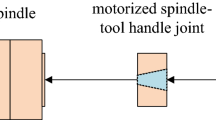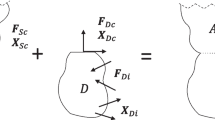Abstract
The utilization of machining robots using industrial six degree-of-freedom (DOF) robot manipulators in the general cutting process is hindered by their cutting instability caused by a significantly lower dynamic stiffness than that of conventional machine tools. The dynamic stiffness of the machining robot is particularly low in low order eigenmodes of approximately 30 Hz or less compared to conventional machine tools. And it is also low in higher order eigenmodes, resulting in reduced cutting stability over the entire machining speed range. In this paper, we propose a frequency response function (FRF) estimation model using an 18 DOF multibody dynamics (MBD) model, which accounts for the key eigenmodes influencing low and high-speed milling, for the purpose of advancing stability improvement methods in robotic machining. First, a method for joint rotational FRF measurement in the joint frame for orthogonal three-directional excitations in the fixed frame is proposed. This not only enables quantitative evaluation of the influence of each joint on the structural dynamic behavior, but also enables model parameter identification with improved accuracy by considering the dynamic behavior of each joint. Subsequently, we employ particle swarm optimization (PSO) to identify the numerous parameters associated with the MBD model, which encompasses an implicit form of equation of motion. Finally, the proposed method is validated by comparing the estimated and measured FRFs.









Similar content being viewed by others
Abbreviations
- DOF:
-
Degree of freedom
- FRF:
-
Frequency response function
- TCP:
-
Tool center point
- MBD:
-
Multibody dynamics
- PSO:
-
Particle swarm optimization
- \(\omega\) :
-
Angular speed
- \(\dot{\omega }\) :
-
Angular acceleration in the link frame
- \(\ddot{x}\) :
-
Linear acceleration in the x direction of the link frame
- \(\ddot{y}\) :
-
Linear acceleration in the y direction of the link frame
- \(\ddot{z}\) :
-
Linear acceleration in the z direction of the link frame
- \(D\) :
-
Distance between two corresponding accelerometers
- \(R\) :
-
A rotation matrix
- \(H\) :
-
TCP FRF matrix
- \({H}_{q}^{x}\) :
-
Joint FRF matrix by excitations in the fixed frame
- \({H}_{q}^{\tau }\) :
-
Joint FRF matrix by excitations in the joint frame
- \(J\) :
-
Jacobian matrix
- \({J}_{v}\) :
-
Linear motion Jacobian matrix
- \({J}_{\omega }\) :
-
Angular motion Jacobian matrix
- \(q\) :
-
Generalized coordinates
- \(F\) :
-
An excitation force in the fixed frame
- \(\tau\) :
-
An excitation torque in the joint frame
- DCIF:
-
Dynamic compliance influence factor
- \({M}_{q}\) :
-
Mass matrix of the machining robot
- \({C}_{q}\) :
-
Damping matrix of the machining robot
- \({K}_{q}\) :
-
Stiffness matrix of the machining robot
- \(m\) :
-
Mass
- \(I\) :
-
Mass moment of inertia
- \(u\) :
-
A unit vector of a joint in the fixed frame
- \(r\) :
-
A position vector between a joint and an inertia in the fixed frame
- \(w\) :
-
A weight function
- \(f\) :
-
A cost function
- \(P\) :
-
A penalty function
- \(g\) :
-
An inequality function
- \(\lambda\) :
-
Lagrange multiplier
- FRAC:
-
Frequency response assurance criterion
- a:
-
An accelerometer mounting location
- b:
-
An accelerometer mounting location
- c:
-
An accelerometer mounting location
- d:
-
An accelerometer mounting location
- x:
-
X direction in the joint frame
- y:
-
Y direction in the joint frame
- z:
-
Z direction in the joint frame
- X:
-
X direction in the fixed frame
- Y:
-
Y direction in the fixed frame
- Z:
-
Z direction in the fixed frame
- cm:
-
Center of mass
References
Pham, A.-D., & Ahn, H.-J. (2021). Rigid precision reducers for machining industrial robots. International Journal of Precision Engineering and Manufacturing, 22, 1469–1486.
Guo, Y., Dong, H., & Ke, Y. (2015). Stiffness-oriented posture optimization in robotic machining applications. Robotics and Computer-Integrated Manufacturing, 35, 69–76.
Lee, J. H., Kim, S. H., & Min, B.-K. (2022). Posture optimization in robotic drilling using a deformation energy model. Robotics and Computer-Integrated Manufacturing, 78, 102395.
Kim, M., Park, H.-W., & Lee, S.-K. (2022). Investigation of machining stability considering thermal and rotation effect: Effectiveness of impact excitation for a rotating spindle. International Journal of Precision Engineering and Manufacturing, 23, 1143–1162.
Pan, Z., Zhang, H., Zhu, Z., & Wang, J. (2006). Chatter analysis of robotic machining process. Journal of materials processing technology, 173(3), 301–309.
Cordes, M., Hintze, W., & Altintas, Y. (2019). Chatter stability in robotic milling. Robotics and Computer-Integrated Manufacturing, 55, 11–18.
Celikag, H., Ozturk, E., & Sims, N. D. (2021). Can mode coupling chatter happen in milling? International Journal of Machine Tools and Manufacture, 165, 103738.
Altintas, Y., Stepan, G., Budak, E., Schmitz, T., & Kilic, Z. M. (2020). Chatter stability of machining operations. Journal of Manufacturing Science and Engineering, 142(11), 52.
Wei, X., Miao, E., & Ye, H. (2022). Analytical prediction of three dimensional chatter stability considering multiple parameters in milling. International Journal of Precision Engineering and Manufacturing, 23, 711–720.
Mousavi, S., Gagnol, V., Bouzgarrou, B. C., & Ray, P. (2017). Dynamic modeling and stability prediction in robotic machining. The International Journal of Advanced Manufacturing Technology, 88, 3053–3065.
Huynh, H. N., Assadi, H., Dambly, V., Rivière-Lorphèvre, E., & Verlinden, O. (2021). Direct method for updating flexible multibody systems applied to a milling robot. Robotics and Computer-Integrated Manufacturing, 68, 102049.
Bottin, M., Cocuzza, S., Comand, N., & Doria, A. (2020). Modeling and identification of an industrial robot with a selective modal approach. Applied Sciences, 10(13), 4619.
Wang, R., Li, F., Niu, J., & Sun, Y. (2022). Prediction of pose-dependent modal properties and stability limits in robotic ball-end milling. Robotics and Computer-Integrated Manufacturing, 75, 102307.
Nguyen, V., & Melkote, S. (2021). Hybrid statistical modelling of the frequency response function of industrial robots. Robotics and Computer-Integrated Manufacturing, 70, 102134.
Chen, H., & Ahmadi, K. (2022). Estimating pose-dependent FRF in machining robots using multibody dynamics and Gaussian Process Regression. Robotics and Computer-Integrated Manufacturing, 77, 102354.
Elliott, A., Pavić, G., & Moorhouse, A. T. (2008). Measurement of force and moment mobilities using a finite difference technique. Journal of the Acoustical Society of America, 123(5), 3312.
Craig, J. J. (2006). Introduction to robotics. Pearson Education.
Ma, Y., Tian, Y., & Liu, X. (2023). Rapid predictions for lower-order dynamics of machine tools based on the rigid multipoint constraints. International Journal of Precision Engineering and Manufacturing, 2, 1–16.
Dumas, C., Caro, S., Garnier, S., & Furet, B. (2011). Joint stiffness identification of six-revolute industrial serial robots. Robotics and Computer-Integrated Manufacturing, 27(4), 881–888.
Huynh, H. N., Rivière-Lorphèvre, E., & Verlinden, O. (2018, June). Multibody modelling of a flexible 6-axis robot dedicated to robotic machining. 5th joint international conference on multibody system Dynamics (pp. 1–18).
Huynh, H. N., Verlinden, O., & Rivière-Lorphèvre, E. (2017). Robotic machining simulation using a simplified multibody model. Annals of DAAAM & Proceedings, 28.
Nefske, D. J., & Sung, S. H. (1996, February). Correlation of a coarse-mesh finite element model using structural system identification and a frequency response assurance criterion. In Proceedings-SPIE the International Society for Optical Engineering (pp. 597–602). SPIE International Society for Optical.
Acknowledgements
This research was funded by the Ministry of Trade, Industry and Energy of Korea (Grant numbers 20018076 and 20012834).
Author information
Authors and Affiliations
Corresponding author
Additional information
Publisher's Note
Springer Nature remains neutral with regard to jurisdictional claims in published maps and institutional affiliations.
Rights and permissions
Springer Nature or its licensor (e.g. a society or other partner) holds exclusive rights to this article under a publishing agreement with the author(s) or other rightsholder(s); author self-archiving of the accepted manuscript version of this article is solely governed by the terms of such publishing agreement and applicable law.
About this article
Cite this article
Oh, C., Lee, JH., Ha, T.I. et al. Model Parameter Identification of a Machining Robot Using Joint Frequency Response Functions. Int. J. Precis. Eng. Manuf. 24, 1647–1659 (2023). https://doi.org/10.1007/s12541-023-00890-9
Received:
Revised:
Accepted:
Published:
Issue Date:
DOI: https://doi.org/10.1007/s12541-023-00890-9




